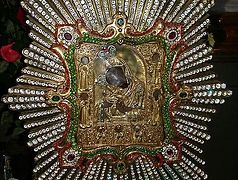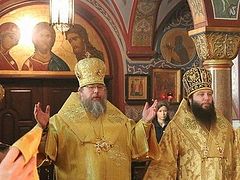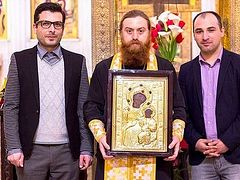We recieved the icon and brought it quickly to the sick children at the Kashirka [Oncology Center.—Trans.]. Fr. Alexiy Kazanchev served the first prayer service in front of the icon. A girl named Olya was the first to venerate it. This was a positive sign for her and her mother, who a year ago had sent a prayer note to Athos for the health of her sick daughter. Olya soon recovered.
We took the icon every week to the chapel of the children’s department at the Oncology Center; we walked with it around the patient rooms so that all the little patients and their parents could pray in front of it. The icon often exuded a fragrance. We did not dare to leave it in the chapel—it wasn’t guarded. We were afraid for our holy icon. Fr. Georgiy took the icon home. It was the most reliable option for us, as his mother always remained at home.
We went to seek advice from the Elder Nikolai on Zalit Island. He confirmed that it was dangerous to leave the icon unprotected in the chapel. He added that we shouldn’t leave it anywhere at all. It sounded like a warning.
Unexpectedly, we received a call from the union of Orthodox Church brotherhoods. Our charitable community had been a member since it was founded. They said that they had received an application from the children’s department of the Oncology Center. It contained a request: the icon of “The Queen of All” should be confiscated from us, as we had allegedly appropriated it, and be returned to the chapel. Not only did this request come out of the blue—it also sounded terribly unfair. Of course, it would have been better to leave the icon in the chapel, but no one could guarantee its safety there!
We went to Igumen Kirill (Sakharov), at that time the chairman of the union of Orthodox Church brotherhoods, taking with us the letter from the iconographer, the receipt confirming the transfer of money to St. Petersburg, and a letter of thanks from the Christ the Savior Cathedral. We showed everything to Father Kirill and he saw for himself that the icon belonged to a private person who had purchased it.
Now we could rightfully say that it was the right thing to do then! We travelled once again to see Elder Nikolai, and he even warned us to never return to the Oncology Center, but to keep the icon in a safe location. Still, the Mother of God didn’t leave the sick children without Her protection—another icon of “The Queen of All” was soon installed in the children’s cancer ward.
What became clear thus far was that it was providential that we had to pay to have a copy of the icon painted in the Vatopedi monastery for our charitable community. The icon had to arrive at the location it stays at today. Had it been gifted to us, we would have had to give it away. And, most likely, it would later have had a different fate.
On the feast of the Nativity of the Most Holy Mother of God, Fr. Georgiy called me and asked to come right away. I witnessed a miracle: the entire icon was overflowing with myrrh. It was dripping down in large drops not only over the icon, but also over a plastic wrap that covered it. The apartment was filled with fragrance. We took it as a sign from above. Not only did it mean that the icon should remain in the church—it also showed the grace-filled power of the icon, eager to pour its grace on a great number of the afflicted and sick. We decided to take the icon around to the local churches. Let the Most Holy Mother of God Herself indicate where She wills Her icon to stay! Soon enough, the icon found its place after having visited only two churches.
On the feast of the Entry of the Most Holy Mother of God into the Temple, the icon exuded myrrh once again. We prayed to receive help from the Mother of God—we couldn’t see clearly what step to take next. So, we decided that we would first show the icon only to priests whom we knew personally. This would safeguard us against certain unpredictable situations. I immediately thought of Fr. Artemy Vladimirov, a well-known priest at the time. I had known him for a long time. He once heard my major first confession and showed me the way toward life in the Church. I called the Church of All Saints in Krasnoye Selo, where batiushka was the rector. Now it is known as the Alexeyevsky monastery.
I was pleasantly surprised—Fr. Artemy picked up the phone himself. When he heard that we wanted to temporarily host at his parish the myrrh-streaming copy of the miracle-working icon from Mount Athos, he reacted on the spot: “The Queen of Heaven Herself?! Visiting us?! Bring Her! I will gather all of our parish this exact evening!”
A crowd of people gathered. Fr. Artemy served a prayer service and we left the icon, expecting to pick it up after Christmas holidays. Fr. Artemy made an announcement about this on the “Radonezh” radio and his church was no longer able to accommodate all those who wanted to attend prayer services there. It was just like Pascha! It seemed as if these unforgettable days of people’s fervor would never end! Just as the Lord once filled the hungry crowd with five loaves of bread, the Mother of God, through “The Queen of All” icon, poured Her grace on anyone who was afflicted.
After the New Year, Fr. Artemy said that the first miracle they witnessed was the healing of a drug addict. His mother attended the prayer service before “The Queen of All,” brought holy water to her home and gave to her stray teenager to drink. His drug dependence was gone! Based on the results of the tests, the doctors confirmed the fact of healing. The young man’s body was completely flushed clean from drugs.
The healings never stopped. Actually, not only cancer patients received help. By the inexpressible grace of the Most Holy Mother of God, many people with various incurable ailments regained their health. We decided to consult with our father confessor Archimandrite Daniel (Voronin; 1952–2020) in the Danilov monastery, who said that the icon shouldn’t be removed from the church. Her place is where She heals.
We needed an akathist written to the “The Queen of All” icon. First of all, we made two translations from the Greek. But both were deemed unacceptable. The repetition of figures of speech and expressions made them too heavy-worded for prayerful reading. I went to Fr. Artemy and asked him to edit the renditions by compiling them into one. Batiushka read them and began making corrections. The work wasn’t moving along due to the difficult language of the texts. Then I suggested composing a new text, in which he could transform its figurative language and make it more palatable to the faithful in Russia, putting aside its previous versions. Thus, the work on the akathist began.
I visited Fr. Artemy at home and wrote down the praise to the Mother of God as it was being composed. Some time passed and the work was finished—all we had left to do was compose a prayer. One evening, I was waiting for batiushka to come and he came late, but he was very tired. We sat down at the table to work. Fr. Artemy sat there lost in his thoughts, apparently praying and comtemplating the text of the prayer. I even thought he had fallen asleep, so I got up very carefully from the table, trying not to disturb him, and was about to leave the room. Suddenly, I heard: “Write this down!” In one breath, he dictated a large prayer that hasn’t had any corrections since. It was a miracle!
But the labor of writing the Akathist wasn’t done yet. Every week during prayer services, when the akathist was read aloud, Fr. Artemy would make some minor corrections, fixing separate words and their combinations. Finally, the new version of the text sparkled with exquisitely balanced spiritual facets.
Fr. Georgiy visited every prayer service. This icon has become his favorite. Every year, when he traveled to Mount Athos on vacation, he would bring to the Vatopedi monastery a list of healings from various illnesses through the prayers to the miracle-working Krasnoselskaya[1] icon. In return, the monks of the monastery told pilgrims from all over the world about these healings. That was when he learned that the iconographer had painted two identical icons at the time—one was sent to us and another one given to the abbot of the monastery. But the icons turned out different.
When the work was completed, Fr. Ephraim selected the one that was painted more carefully and destined for Russia. However, apparently the icon’s beauty isn’t of paramount importance. One day, Fr. Georgiy brought two “Queen of All” icons from the monastery—they were the colorful, framed illustrations of the miracle-working icon the same size as the miracle-working one. Fr. Ephraim, the abbot of the monastery, presented them to us.
A few years later, on June 18, 2011, Fr. Georgiy died of cancer. Before his death, he took monastic vows with the new name of Luke. With the blessing of His Holiness Patriarch Kirill, he was tonsured by his father confessor Archimandrite Daniel. Apparently, his illness was meant to be a test to make his soul pure and to prepare him for the transition to the Kingdom of Heaven. He lived his life here on earth as if he was already living in Heaven. His merciful heart had enough room for the pain and suffering of others. Every day, he would rush to help other people. He could do many things himself. He completed much for the glory of God. People gratefully cherish the memory of this amazing man.
“The Queen of All” icon is well loved here in Russia. It is hard to find a church these days that doesn’t have this icon. The Most Holy Mother of God spreads Her grace-filled, life-giving omophorion over everyone who appeals to Her for help before Her icon. Countless miracles are taking place. They are the signs of Her good will to all the infirm and burdened by the hardships of life and the bonds of sin. Many people who waste their lives as unbelievers and people of little faith can’t see the true way of salvation. Once facing a difficult situation, they appeal to “The Queen of All” and almost all of them find faith.
“The Queen of All” icon is greatly loved in Russia
We can use the following situation that happened with one family as an example. A certain young couple led a godless lifestyle. A child was born to them. After some time, their baby, not even a year old, was diagnosed with liver cancer. Standard treatment didn’t help. One woman, a believer, gave them a paper icon of “The Queen of All”, the akathist and oil consecrated at the prayer service before the miracle-working icon. She told them they are to read the akathist for forty days and anoint their child with the holy oil. The baby’s mother was told to go to confession and receive Holy Communion every week. The parents did everything as they were told, and vowed before God to have a church wedding if their child would be healed. After forty days, they went to have another medical examination, and it showed that their baby was perfectly healthy.
Once, Emperor Theodosius the Great (379–395AD), having learned about the rescue of his son from the depths of the sea by the Most Holy Mother of God, erected the Annunciation Cathedral in the ruins of the Vatopedi monastery at the place where his son was found. In the same way, any afflicted person, turned from a perilous path through the intercession of the Mother of God, continues to build the temple of his soul maintains good assurance that he is being saved through Her prayers.




